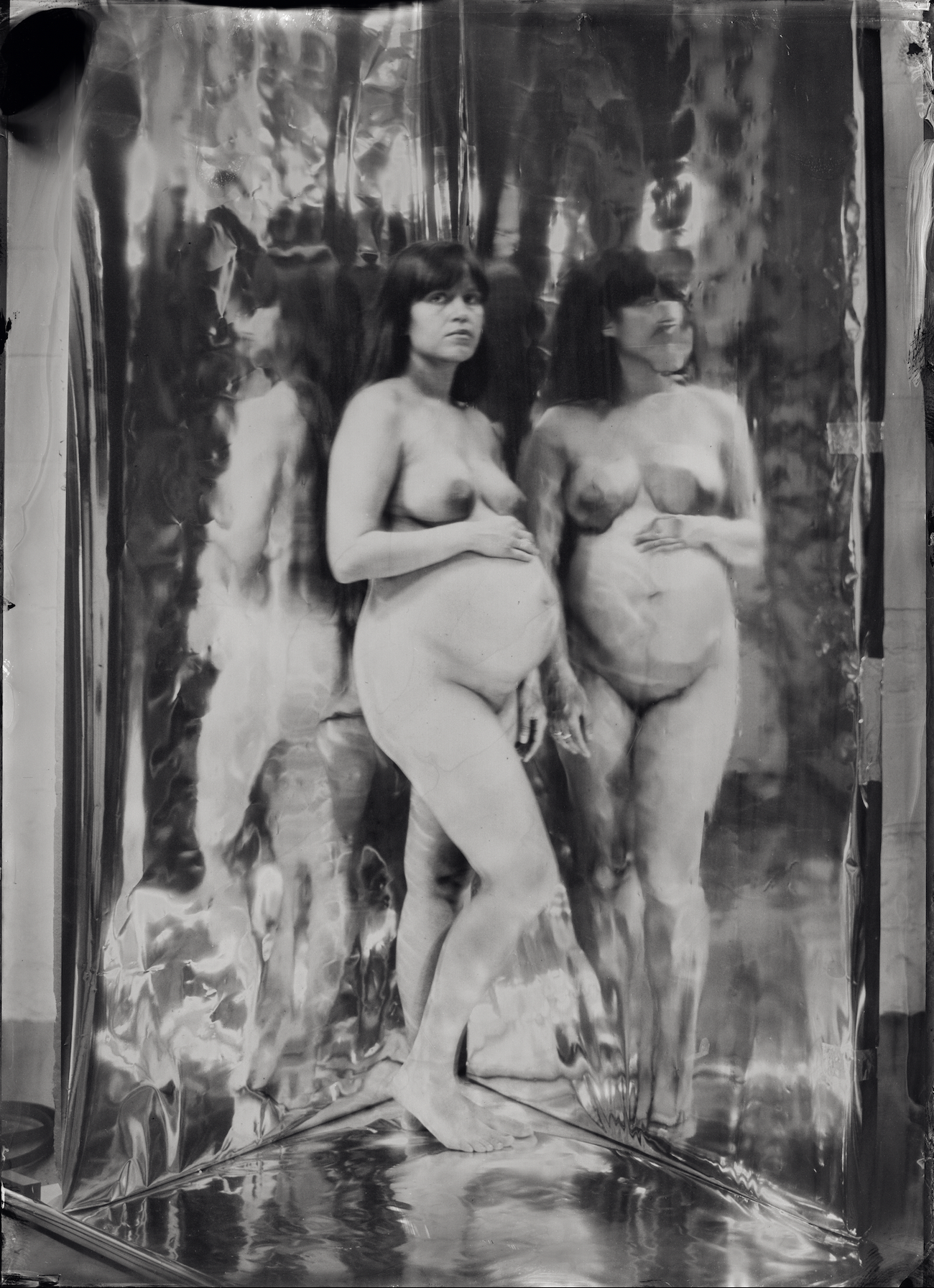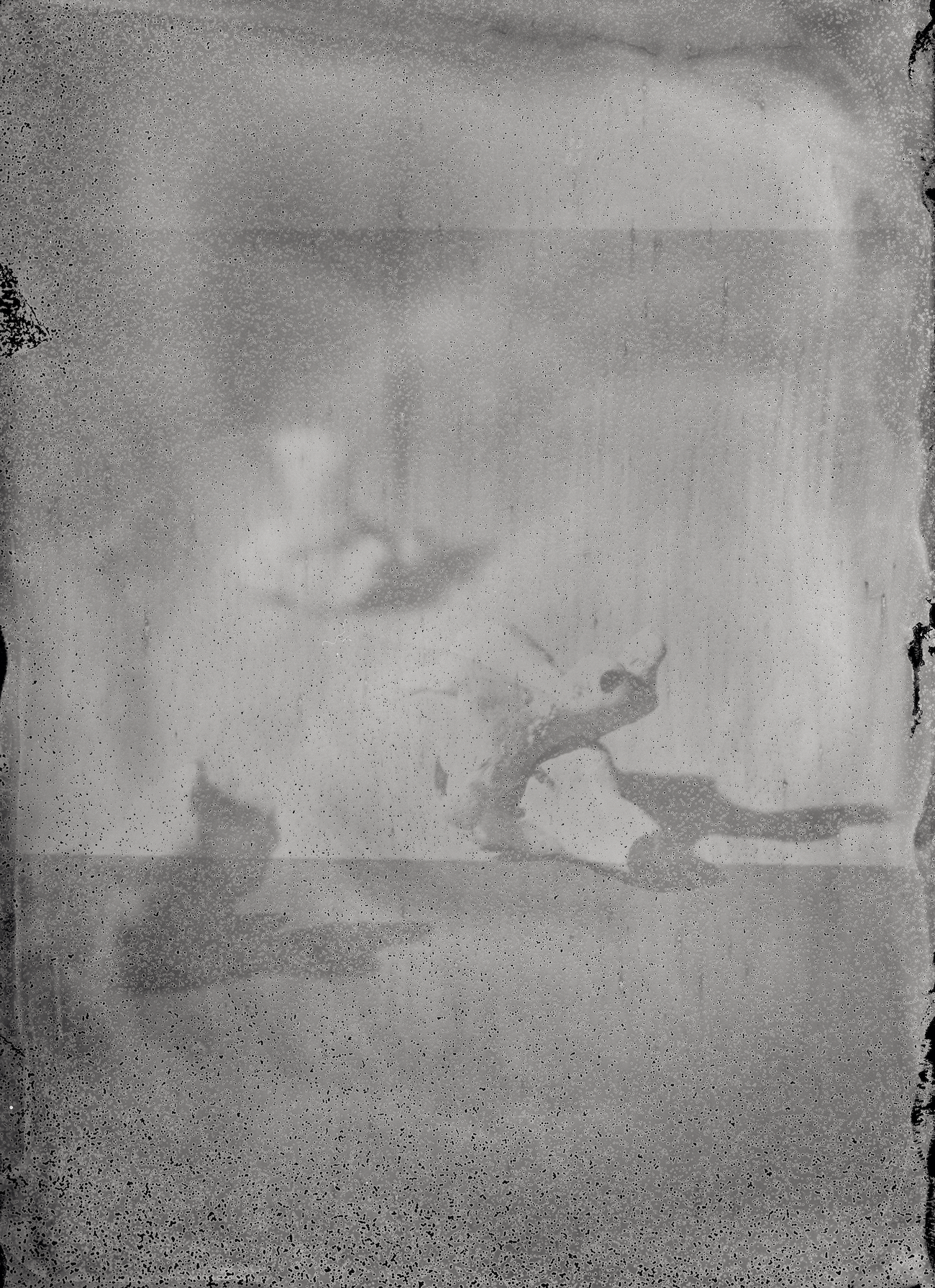Camille Liu and Kasia Wozniak in conversation at Sarabande Foundation
All images courtesy of Kasia Wozniak.
Camille Liu: You have a very unique practice working with specific processes. Can you explain those processes and speak a bit about how you fell in love with this signature way of working?
Kasia Wozniak: I work predominantly with wet plate collodion, sometimes with cyanotype, and with direct color paper positives. It’s mainly because I want to be able to make everything. I never want my pictures to look like they come from the time in which they’ve been made. I want them to be suspended between eras, like a memory. I was having a battle with wet plate for a long time because the process is so old, there an inevitable notion of time carried with the process. I found a picture in the market in Vienna and thought I really want to make exactly this. That is how it all began.
CL: What value does the analog process grant your photographs? What is your relationship to digital photography?
KW: I don’t really use digital cameras. I have thousands of photos on my phone, as everybody does. But for me photography is more about tangibility and the possession of the physical, as well as what that physicality means. I don’t create a lot – whenever I shoot an editorial story, it’s always twelve or fifteen photographs, sometimes eight or ten. I struggle with making choices as well, so for me less is more. I am trying to challenge the constant battle of whether something is good enough. Whether you can ever be satisfied – reflecting on the world we are living in today – finding joy somewhere when there is not a lot of it out there. When it comes to my pictures, I am not a documentary photographer at all. I am a person who sets things up and is in control of everything. There is spontaneity in my work. It exists within the field of me processing the pictures in the darkroom and being on set with someone and thinking to myself “I want to freeze this moment”. However, it is very much a controlled freeze, unlike documenting someone having a coffee at a bar. I’m not like Cartier-Bresson walking the streets of Paris. It’s not the same. It’s a very different approach to photography.
CL: Your work hides details in each photograph to merge a modern subject with a nineteenth century process. Photographs in the nineteenth century were highly composed and structured. How does that aspect interact with your practice?
KW: All of my exposures are very long. I think between ten to forty seconds. I could use flash in my practice and balance it out, but it’s not something that I’m interested in because that length of time is really important to me. It mirrors my moment with the sitter. There’s that sort of sacred, mythical element of photography, especially in Victorian photography, which I’m channeling. In the nineteenth century, it was a big deal to be photographed. In the photos I take, you will always see trainers, or something really contemporary in the shot. It can be a plug or a heater or a lightstand or anything that refers to today really. I work with a lot of different poses, and I try to challenge and break them up. I give it more of a contemporary spin when it comes to directing the shoot. Because of the nature of the process, certain colors are not read, so one always will get that powerful sensation of being somewhere else.
CL: Photography is an art of stillness, a millisecond captured. How does the presence of time inform your photographs?
KW: It’s really important for me, the slowness, especially within the times we are living in. I’m trying to do the same thing with color photographs. When I started working with color, I was using flash because I was interested in making sure everything was correct and filtered. I wanted to have control over color. Then, suddenly, I let go and saw what happened when the color wasn’t perfect. The less control I have, the more excited I become. Time is really important because it carries the consciousness of being present with someone in the room. I find this to be quite magical especially since I never work with a big set of people at once. There’s always a stylist, some assistants, but not too many. It’s a very trusted team, and because it’s so intimate, whenever I frame something, I need the model to be one hundred percent with me. Those ten or twenty seconds can be the longest seconds of your life. Suddenly time changes. That is because I’m fascinated by time itself – what time means and what it means to live and become.
CL: Can you speak a bit about subject selection for your photographs, especially regarding your editorial work?
KW: I am definitely seeking eclecticism and diversity. When you look at my editorial work, everything is street casted. I walk by someone and I really like how they look. I used to photograph a lot of people I knew, people I would pass on the street. There are some people I like to go back and photograph. I think my love for photography started here. For me, it’s important not to forget about the past. In a personal project, I always try to weave that in. Memories, the past, time – all of these elements are part of the significance of an object or photograph. We are living in very strange times with regards to photography because we question the image, constantly. Photography is in a very strange place, and I’m definitely chasing the tangible aspect of it. I try to document things around me. Fashion is something I’ve always liked as a platform, and photography lets me explore it well.
CL: You are currently working on a project in which you interact further with your photographs and weave them together; intertwining multiple images to create new pictures. You play with the negative and positive. What inspired the addition of this new facet of collage to your practice?
KW: Frank Bowling, I think. I once was in a studio with Frank Bowling, and he asked me, “what do you see?”; I said “I see a running woman”. He’s an abstract painter. He said “Take a black marker pen and outline the running woman for me”. I thought okay, I might as well, he will never ask me again to draw on one of his paintings. So I took the marker pen and outlined the running woman. He came over to the painting and asked me to pass him a bottle of liquid, which he sprayed over it, and this running woman started crying, almost dissolving – it looked incredible. He turned to me and said, “In life, you’ve got to take risks”. That was one of many moments I spent in his studio. With wet plate, I really choose which work I photograph as positive versus which as negative. It’s all to do with the material, what it gives. The metal plate is more like a direct positive, almost like a polaroid. However, the fragility of the glass is something beyond. It adds another context in. It’s only when you asked me this question that it appeared to me that I’m doing the same thing through my color work. I am still working with positives and negatives. For example, when I shot Rachel Scott’s wardrobe, I shot each piece as positive, and developed them as positive and negative. Remembering what Frank told me, I suddenly thought, I just want to cut them out. Maybe this was born there. To take the risk and cut the negative up. It’s the only one you have, but maybe something beautiful will come out of it. It’s really important for me that I have one negative. I do reprint my work, but I only have one negative. So it becomes almost its own right. It stands for itself and exists without anything else.
All images courtesy of Kasia Wozniak.


